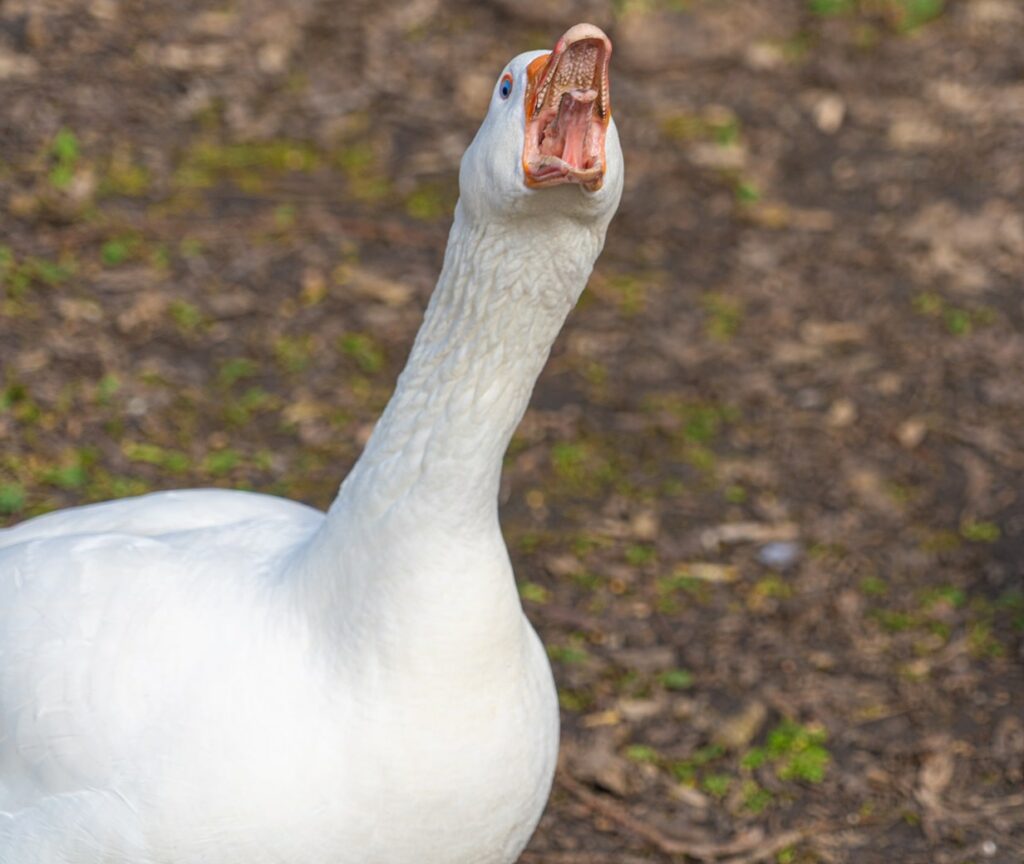A lot of people find geese intimidating. People are even more frightened when they see inside the fowl’s mouth.
Geese don’t have teeth. Although it looks as though geese have teeth along their beaks and tongues, those spikes are called tomia. These birds do use tomia for the same purposes that mammals use their teeth. However, tomia and teeth are different from each other.
Taking a look inside a goose’s mouth is actually very interesting. While their mouths may look like something out of your nightmares, these birds are actually harmless.

Do Geese Have Real Teeth?
Geese don’t have real teeth. When you look inside a goose’s mouth, you’ll notice 3 rows of spikes. There will be a row on its upper and lower beak, as well as its tongue. These spikes are tomia, otherwise known as conical papillae.
So, what makes tomia and teeth different from one another? Tomia and teeth look very similar and serve the same purpose. What makes them different is what they are made from. Teeth are composed of enamel, which is a bone. Tomia is composed of cartilage and isn’t made from bone.
Since tomia are composed of cartilage, they’re more flexible than teeth. This makes it easier for the goose to grip its food while eating.
It’s not just what they’re made of that sets teeth and tomia apart. If you were to look at the mouth of an animal with teeth, you’ll notice every tooth is separate. This is why teeth can be lost, one at a time. On the other hand, tomia are all connected. For this reason, geese won’t lose their tomia.
Do Geese Bite?
A goose’s tomia do look frightening at first. This can make a person worry when they see geese at the park. Is getting bitten by a goose something that people need to worry about?
So, geese do have a reputation for biting, but it’s not as bad as it sounds. These birds are known to nip at people when they get too close. Since they are confident birds, they are more likely to nip at a person than they are to run away from the scene. However, people that have been bitten by a goose before claim that it doesn’t hurt.
Goose bites feel more like a gentle pinch than a bite. You see, the tomia itself isn’t big. They are smaller spikes that are solely for helping the birds eat. That is why a goose bite likely won’t put you in the hospital. They are known more for little nips than actual bites.
One thing to keep in mind is that geese don’t like to share their space. If other animals or people invade an area where geese are, the birds may become aggressive. For the most part, geese won’t hurt people. However, if a goose is being taunted or feels threatened, it could become aggressive enough to cause serious injury.

How Tomia Helps Geese Eat
Geese are known to eat grass, leaves, and plants that they can rip from the ground. They also eat insects and small mammals, like rodents. The way the tomia lines the goose’s beak and tongue assists it in eating.
Since geese usually eat tough food, the tomia allow them to grip the food. Another interesting fact about geese is that they don’t chew their food. This is one of the main reasons why they have tomia on their tongues.
The tomia help them gather the food to be swallowed. What they eat ends up getting broken down in the gizzard, which is an organ in the digestive tract. This organ can grind up tough foods to smaller bits before it enters the stomach.
Do Any Birds Have Teeth?
Geese aren’t the only birds without teeth. In fact, there aren’t any bird species with teeth. Birds need to be as light as possible for flight. Enamel makes teeth very heavy, which can affect a bird’s flying abilities.
Instead, birds rely on the ridges on their bills to grasp food. Then, similar to geese, the food will get broken down in the gizzard. The type of ridges that are on a bird’s bill are based on what type of food they eat.
- Birds that feed on seeds have ridged tomia to help them crack through the seed’s shell
- Birds that catch fish or rodents have serrated tomia, similar to the blades of a saw, that help them catch their prey
Also Read: What is a Group of Geese Called
Do Geese Have Egg Tooth?
Geese, like most birds, are born with a horn that is referred to as an “egg tooth”. This tooth can be found on their upper bill, but it is only there for the first few days of a gosling’s life. The gosling uses this tooth and a muscle in its head to break out of the egg.
Goslings can emerge from the egg by puncturing it with their egg tooth. Once they puncture the first hole, they will work their way around the entire egg until they are able to emerge. Some goslings take a few hours to hatch from the egg, while others could take a couple of days.
